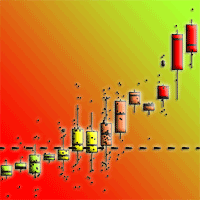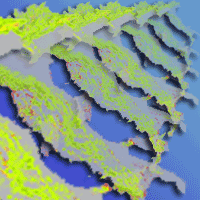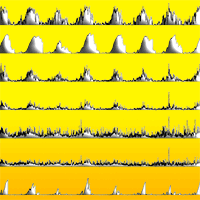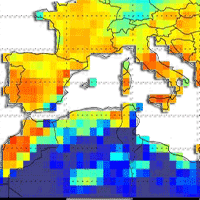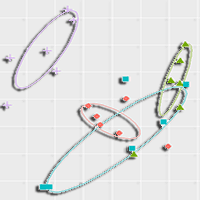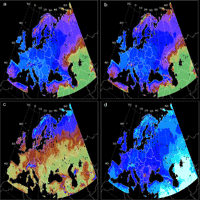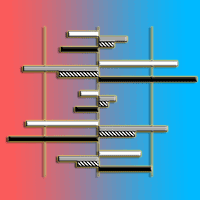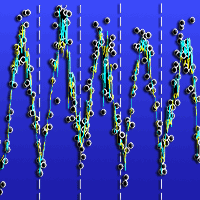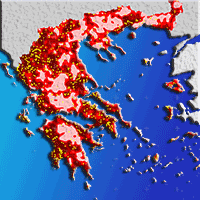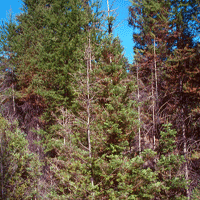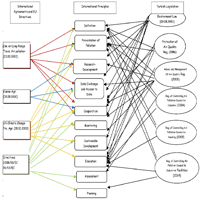Enhanced flammability is a key driver of community assembly and a favored characteristic in fire-dependent ecosystems. In this study, we examined the variability of flammability traits among Mediterranean woody species. We measured eight flammability traits, including leaf traits, branching architecture, and standing biomass traits, across 26 woody species in the understory of pine forests in southwestern Anatolia, Turkey. Given that these species are part of fire-dependent plant communities, where fire provides advantages for persistence, we hypothesized that species would use various ways to increase their flammability. All flammability traits exhibited substantial variation among species. The flammability of the studied species varied depending on the specific trait considered, with no single species consistently exhibiting higher or lower flammability across all traits. Moreover, many species employed distinct strategies to enhance their flammability, such as differences in leaf structure, branching patterns, and biomass characteristics. The interspecific variability in flammability was also evident through a calculated flammability score based on eight traits, providing a valuable framework for ranking species by their flammability. Our findings suggest that the traits driving increased flammability in Mediterranean woody plants are idiosyncratic at the species level. Therefore, multiple traits must be considered to comprehensively study flammability within a plant community. These results have practical implications for the selection of “fire-resistant” plants in land management strategies within the Mediterranean Basin.
Keywords
, , , ,
Citation
Aktepe N, Tavsanoglu Ç (2025). Multiple ways for enhancing flammability in Mediterranean woody species: a trait-based approach. iForest 18: 301-308. - doi: 10.3832/ifor4601-018
Academic Editor
Lorenzo Mw Rossi
Paper history
Received: Mar 13, 2024
Accepted: Jun 05, 2025
First online: Oct 20, 2025
Publication Date: Oct 31, 2025
Publication Time: 4.57 months
© SISEF - The Italian Society of Silviculture and Forest Ecology 2025
Open Access
This article is distributed under the terms of the Creative Commons Attribution-Non Commercial 4.0 International (https://creativecommons.org/licenses/by-nc/4.0/), which permits unrestricted use, distribution, and reproduction in any medium, provided you give appropriate credit to the original author(s) and the source, provide a link to the Creative Commons license, and indicate if changes were made.

Breakdown by View Type
(Waiting for server response...)
Article Usage
Total Article Views: 1167
(from publication date up to now)
Breakdown by View Type
HTML Page Views: 349
Abstract Page Views: 399
PDF Downloads: 388
Citation/Reference Downloads: 1
XML Downloads: 30
Web Metrics
Days since publication: 53
Overall contacts: 1167
Avg. contacts per week: 154.13
Article Citations
Article citations are based on data periodically collected from the Clarivate Web of Science web site
(last update: Mar 2025)
(No citations were found up to date. Please come back later)
Publication Metrics
by Dimensions ©
Articles citing this article
List of the papers citing this article based on CrossRef Cited-by.
(1)
Alam AM, Wyse SV, Buckley HL, Perry GL, Sullivan JJ, Mason NW, Buxton R, Richardson SJ, Curran TJ (2020)Shoot flammability is decoupled from leaf flammability, but controlled by leaf functional traits. Journal of Ecology 108: 641-653.
CrossRef |
Gscholar
(2)
Baeza MJ, Santana VM (2015)Biological significance of dead biomass retention trait in Mediterranean Basin species: an analysis between different successional niches and regeneration strategies as functional groups. Plant Biology 17: 1196-1202.
CrossRef |
Gscholar
(3)
Bond WJ, Midgley JJ (1995)Kill thy neighbour: an individualistic argument for the evolution of flammability. Oikos 73: 79-85.
CrossRef |
Gscholar
(4)
Clarke PJ, Lawes MJ, Midgley JJ, Lamont BB, Ojeda F, Burrows GE, Enright NJ, Knox KJE (2013)Resprouting as a key functional trait: how buds, protection and resources drive persistence after fire. New Phytologist 197: 19-35.
CrossRef |
Gscholar
(5)
Cui X, Paterson AM, Wyse SV, Alam MA, Maurin KJ, Pieper R, Padullés Cubino J, Connell DM, Donkers D, BréDa J, Buckley HL, Perry GLW, Curran TJ (2020)Shoot flammability of vascular plants is phylogenetically conserved and related to habitat, fire-proneness and growth form. Nature Plants 6: 355-359.
CrossRef |
Gscholar
(6)
Cubino JP, Buckley HL, Day NJ, Pieper R, Curran TJ (2018)Community-level flammability declines over 25 years of plant invasion in grasslands. Journal of Ecology 106: 1582-1594.
CrossRef |
Gscholar
(7)
De Lillis M, Bianco PM, Loreto F (2009)The influence of leaf water content and isoprenoids on flammability of some Mediterranean woody species. International Journal of Wildland Fire 18: 203-212.
CrossRef |
Gscholar
(8)
Dimitrakopoulos AP, Papaioannou KK (2001)Flammability assessment of Mediterranean forest fuels. Fire Technology 37: 143-152.
CrossRef |
Gscholar
(9)
Engber EA, Varner JM (2012)Patterns of flammability of the California oaks: the role of leaf traits. Canadian Journal of Forest Research 42: 1965-1975.
CrossRef |
Gscholar
(10)
Ganteaume A, Marielle J, Corinne JM, Thomas C, Laurent B (2009)Fuel characterization and effects of wildfire recurrence on vegetation structure on limestone soils in southeastern France. Forest Ecology and Management 258: 15-23.
CrossRef |
Gscholar
(11)
Grootemaat S, Wright IJ, Van Bodegom PM, Cornelissen JH, Cornwell WK (2015)Burn or rot: leaf traits explain why flammability and decomposability are decoupled across species. Functional Ecology 29: 1486-1497.
CrossRef |
Gscholar
(12)
Grootemaat S, Wright IJ, Van Bodegom PM, Cornelissen JHC (2017)Scaling up flammability from individual leaves to fuel beds. Oikos 126: 1428-1438.
CrossRef |
Gscholar
(13)
Güney CO, Sari A, Cekim HO, Küçüksille EU, Sentürk O, Gülsoy S, Ozkan K (2022)An advanced approach for leaf flammability index estimation. International Journal of Wildland Fire 31: 277-290.
CrossRef |
Gscholar
(14)
Jaureguiberry P, Díaz S (2023)A three-dimensional approach to general plant fire syndromes. Functional Ecology 37: 2143-2158.
CrossRef |
Gscholar
(15)
Kattge J, Bönisch G, Díaz S, Lavorel S, Prentice IC, Leadley P (2020)TRY plant trait database - Enhanced coverage and open access. Global Change Biology 26 (1): 119-188.
CrossRef |
Gscholar
(16)
Keeley JE (2002)Native American impacts on fire regimes of the California coastal ranges. Journal of Biogeography 29: 303-320.
CrossRef |
Gscholar
(17)
Keeley JE, Pausas JG, Rundel PW, Bond WJ, Bradstock RA (2011)Fire as an evolutionary pressure shaping plant traits. Trends in Plant Science 16: 406-411.
CrossRef |
Gscholar
(18)
Keeley JE, Bond WJ, Bradstock RA, Pausas JG, Rundel PR (2012)Fire in the Mediterranean ecosystem: ecology, evolution and management. Cambridge University Press, Cambridge, UK, pp. 515.
Gscholar
(19)
Krix DW, Murray BR (2018)Landscape variation in plant leaf flammability is driven by leaf traits responding to environmental gradients. Ecosphere 9: e02093.
CrossRef |
Gscholar
(20)
Lamont BB, He T, Yan Z (2019)Evolutionary history of fire-stimulated resprouting, flowering, seed release and germination. Biological Reviews 94: 903-928.
CrossRef |
Gscholar
(21)
Lamont BB, Pausas JG, He T, Witkowski ETF, Hanley ME (2020)Fire as a selective agent for both serotiny and nonserotiny over space and time. Critical Reviews in Plant Sciences 39: 140-172.
CrossRef |
Gscholar
(22)
Marlon J, Bartlein P, Carcaillet C, Gavin D, Harrison S, Higuera P, Joos F, Power M, Prentice I (2008)Climate and human influences on global biomass burning over the past two millennia. Nature Geoscience 1: 697-702.
CrossRef |
Gscholar
(23)
Michelaki C, Fyllas NM, Galanidis A, Aloupi M, Evangelou E, Arianoutsou M, Dimitrakopoulos PG (2020)Adaptive flammability syndromes in thermo-Mediterranean vegetation, captured by alternative resource-use strategies. Science of the Total Environment 718: 137437.
CrossRef |
Gscholar
(24)
Montgomery KR, Cheo PC (1971)Effect of leaf thickness on ignitibility. Forest Science 17: 475-478.
CrossRef |
Gscholar
(25)
Moreira B, Castellanos MC, Pausas JG (2014)Genetic component of flammability variation in a Mediterranean shrub. Molecular Ecology 23: 1213-1223.
CrossRef |
Gscholar
(26)
Murray BR, Hardstaff LK, Phillips ML (2013)Differences in leaf flammability, leaf traits and flammability-trait relationships between native and exotic plant species of dry sclerophyll forest. PloS One 8: e79205.
CrossRef |
Gscholar
(27)
Murray BR, Brown C, Murray ML, Krix D, Martin LJ, Hawthorne T, Wallace MI, Potvin SA, Webb JK (2020)An integrated approach to identify low-flammability plant species for green firebreaks. Fire 3: 9.
CrossRef |
Gscholar
(28)
Mutch RW (1970)Wildland fires and ecosystems - A hypothesis. Ecology 51: 1046-1051.
CrossRef |
Gscholar
(29)
Neyisçi T (1996)Kolay ve güç yanan bitki türleri [Plant species easy and difficult to burn]. Orman Mühendisligi Dergisi 33: 3-9. [in Turkish]
Gscholar
(30)
Oztürk MG, Bekar I, Tavsanoglu C (2024)Rethinking lightning-induced fires: spatial variability and implications for management policies. Forest Ecology and Management 572: 122262.
CrossRef |
Gscholar
(31)
Parsons AL, Balch JK, De Andrade RB, Brando PM (2015)The role of leaf traits in determining litter flammability of south-eastern Amazon tree species. International Journal of Wildland Fire 24: 1143-1153.
CrossRef |
Gscholar
(32)
Pausas JG, Keeley JE (2009)A burning story: the role of fire in the history of life. BioScience 59: 593-601.
CrossRef |
Gscholar
(33)
Pausas JG, Alessio GA, Moreira B, Corcobado G (2012)Fires enhance flammability in
Ulex parviflorus. New Phytologist 193: 18-23.
CrossRef |
Gscholar
(34)
Pausas JG (2015)Bark thickness and fire regime. Functional Ecology 29: 315-327.
CrossRef |
Gscholar
(35)
Pausas JG, Alessio GA, Moreira B, Segarra-Moragues JG (2016)Secondary compounds enhance flammability in a Mediterranean plant. Oecologia 180: 103-110.
CrossRef |
Gscholar
(36)
Pausas JG, Keeley JE, Schwilk DW (2017)Flammability as an ecological and evolutionary driver. Journal of Ecology 105: 289-297.
CrossRef |
Gscholar
(37)
Peel MC, Finlayson BL, McMahon TA (2007)Updated world map of the Köppen-Geiger climate classification. Hydrology and Earth System Sciences 11: 1633-1644.
CrossRef |
Gscholar
(38)
Pérez-Harguindeguy N, Díaz S, Garnier E, Lavorel S, Poorter H, Jaureguiberry P, Bret-Harte MS, Cornwell WK, Craine JM, Gurvich DE, Urcelay C, Veneklaas EJ, Reich PB, Poorter L, Wright IJ, Ray P, Enrico L, Pausas JG, De Vos AC, Buchmann N, Funes G, Quétier F, Hodgson JG, Thompson K, Morgan HD, Steege H, Van Der Heijden MGA, Sack L, Blonder B, Poschlod P, Vaieretti MV, Conti G, Staver AC, Aquino S, Cornelissen JHC (2013)New handbook for standardised measurement of plant functional traits worldwide. Australian Journal of Botany 61: 167-234.
CrossRef |
Gscholar
(39)
Plucinski MP, Anderson WR (2008)Laboratory determination of factors influencing successful point ignition in the litter layer of shrubland vegetation. International Journal of Wildland Fire 17: 628-637.
CrossRef |
Gscholar
(40)
Popović Z, Bojović S, Marković M, Cerdà A (2021)Tree species flammability based on plant traits: a synthesis. Science of the Total Environment 800: 149625.
CrossRef |
Gscholar
(41)
Santacruz-García AC, Bravo S, Del Corro F, Ojeda F (2019)A comparative assessment of plant flammability through a functional approach: the case of woody species from Argentine Chaco region. Austral Ecology 44: 1416-1429.
CrossRef |
Gscholar
(42)
Santana VM, Baeza JM, Valdecantos A, Vallejo RV (2018)Redirecting fire-prone Mediterranean ecosystems toward more resilient and less flammable communities. Journal of Environmental Management 215: 108-115.
CrossRef |
Gscholar
(43)
Saura-Mas S, Paula S, Pausas J, Lloret F (2010)Fuel loading and flammability in the Mediterranean Basin woody species with different post-fire regenerative strategies. International Journal of Wildland Fire 19: 783-794.
CrossRef |
Gscholar
(44)
Scarff FR, Westoby M (2006)Leaf litter flammability in some semi-arid Australian woodlands. Functional Ecology 20: 745-752.
CrossRef |
Gscholar
(45)
Schertzer E, Staver AC (2018)Fire spread and the issue of community-level selection in the evolution of flammability. Journal of the Royal Society Interface 15: 20180444.
CrossRef |
Gscholar
(46)
Schwilk DW (2003)Flammability is a niche construction trait: canopy architecture affects fire intensity. American Naturalist 162: 725-733.
CrossRef |
Gscholar
(47)
Schwilk DW, Kerr B (2002)Genetic niche-hiking: an alternative explanation for the evolution of flammability. Oikos 99: 431-442.
CrossRef |
Gscholar
(48)
Shipley B, Vu TT (2002)Dry matter content as a measure of dry matter concentration in plants and their parts. New Phytologist 153: 359-364.
CrossRef |
Gscholar
(49)
Snyder JR (1984)The role of fire: Mutch ado about nothing? Oikos 43: 404-405.
CrossRef |
Gscholar
(50)
Stevens JT, Kling MM, Schwilk DW, Varner JM, Kane JM (2020)Biogeography of fire regimes in western US conifer forests: a trait-based approach. Global Ecology and Biogeography 29: 944-955.
CrossRef |
Gscholar
(51)
Tavsanoglu C, Pausas JG (2018)A functional trait database for Mediterranean Basin plants. Scientific Data 5: 18013.
CrossRef |
Gscholar
(52)
Trabaud L (1976)Inflammabilité et combustibilité des principales espèces des garrigues de la région méditerranéenne [Flammability and combustibility of the main species of garrigue in the Mediterranean region]. Oecologia Plantarum 11: 117-136. [in French]
Gscholar
(53)
Troumbis AY, Trabaud L (1989)Some questions about flammability in fire ecology. Acta Oecologia - Oecologica Plantarum 10: 167-175.
Gscholar
(54)
Tüfekcioglu I, Tavsanoglu C (2022)Diversity and regeneration strategies in woody plant communities of the Mediterranean Basin: Vegetation type matters. Plant Biosystems 156: 1247-1259.
CrossRef |
Gscholar
